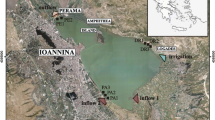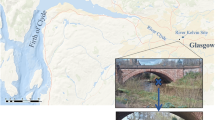Abstract
Metal-containing granules in the mucus trails of the marine gastropod Littorina littorea from nine sites in north-east England were analysed for elemental composition by X-ray microanalysis and characterised relative to a putative gradient of pollution. Overall granule density varied significantly between sites, means of 6.5–17.0 per field of view (2688 μm?). Most granules found (64%) were poly-metal of a wide variety of compositions, but could be classified as Si+X, Mg+X, S+X, Na+X, P+Ca, P+Al, where X indicates any other combination of elements. Si+Al+X accounted for 61% of the poly-metal granules found and was considered to be contamination from the beach substratum. In single-metal granule form only Ca, Si, Fe, Ti, Al and Na were found. The most common single-metal granule at each site was of Ca, except at two sites, where the most common single-metal granule was of Si. The densities of these granule types varied between sites but differences were found to be significant only in the case of Si granules. Across all sites, single-metal granules of Si (mean=2.49 μm ± 1.44 SD, n=141) and Ca (2.22 μm ± 1.08 SD, n=147) were significantly larger than granules of Fe (1.74 μm ± 0.95 SD, n=63) and Ti (1.24 μm ± 0.52 SD, n=18). The range of sizes was large: Ca (0.5–6 μm), Si (0.5–10 μm), Fe (0.3–4.1 μm), Ti (0.5–2.5 μm). Between the sites there were significant differences in the size of Fe and Si granules but not Ca or Ti granules. Despite these variations in granule type and size, there was no evidence of a relationship with pollution and consequently a detoxifying function of the mucus trail in metal polluted environments is not apparent.





Similar content being viewed by others
References
Bebiano MJ, Langston WJ, Simkiss K (1992) Metallothionein induction in Littorina littorea (Mollusca, Prosobranchia) on exposure to cadmium. J Mar Biol Ass UK 72:329–342
Bretz DD, Dimock RV (1983) Behaviourally important characteristics of the mucus trail of the marine gastropod Ilyanassa obsoleta. J Exp Mar Biol Ecol 71:181–191
Brown BE (1982) The form and function of metal-containing ‘granules’ in invertebrate tissues. Biol Rev 57:621–667
Bryan GW, Langston WJ, Hummerstone LG, Burt GR (1985) A guide to the assessment of heavy-metal contamination in estuaries using biological indicators. Marine Biological Association of the United Kingdom Occasional Publication No 4, 92 pp
Bryan GW, Langston WJ, Hummerstone LG, Burt GR, Ho YB (1983) An assessment of the gastropod, Littorina littorea, as an indicator of heavy-metal contamination in United Kingdom estuaries. J Mar Biol Ass UK 63:327–345
Davies MS, Cliffe EJ (2000) Adsorption of metals in seawater to limpet (Patella vulgata) pedal mucus. Bull Environ Contam Toxicol 64:228–234
Davies MS, Hatcher AM (1999) Limpet mucus as a depuration route and potential biomonitor. Ecotoxicol 8:177–187
Davies MS, Hawkins SJ (1998) Mucus from marine molluscs. Adv Mar Biol 34:1–71
Davies MS, Hutchinson SJ (1995) Crystalline calcium in littorinid mucus trails. Hydrobiologia 309:117–121
Davies MS, Jones HD and Hawkins SJ (1992) Pedal mucus production in Littorina littorea. In: Grahame J, Mill PJ, Reid DG (eds) Proceedings of the 3rd International Symposium on Littorinid Biology. The Malacological Society of London, London, pp227–233
Davies MS, Proudlock DJ, Mistry A (2005) Metal content of the radula of the common limpet, Patella vulgata L., from ten sites. Ecotoxicol 14:463–473
De Wolf H, Backeljau T, Blust R (2000) Heavy metal accumulation in the periwinkle Littorina littorea, along a pollution gradient in the Scheldt estuary. Sci Total Environ 262:111–121
Fergusson JE (1990) The heavy elements: chemistry, environmental impact and health effects. Pergamon, Oxford
Giusti L (2001) Heavy metal contamination of brown seaweed and sediments from the UK coastline between the Wear river and the Tees river. Env Internat 26:275–286
Hyslop BT, Davies MS, Arthur W, Gazey NJ, Holroyd S (1997) Effects of colliery waste on littoral communities in north-east England. Environ Poll 96:383–400
Ireland MP (1979) Distribution of essential and toxic metals in the terrestrial gastropod Arion ater. Environ Poll 20:271–278
Jugdaohsingh R, Campbell MM, Thomson RPH, McCrohan CR, White KN, Powell JJ (1998) Mucus secretion by the freshwater snail Lymnaea stagnalis limits aluminium concentration of the aqueous environment. Environ Sci Technol 32:2591–2595
Juniper SK, Thompson JAJ, Calvert SE (1986) Accumulation of minerals and trace elements in biogenic mucus at hydrothermal vents. Deep-Sea Res 33:339–347
Kádár E, Salánki J, Jugdaohsingh R, Powell JJ, McCrohan CR, White KN (2001) Avoidance responses to aluminium in the freshwater bivalve Anodonta cygnea. Aquat Toxicol 55:137–148
Kang S, Choi M, Oh I, Wright DA, Koh C (1999) Assessment of metal pollution in Onsan Bay, Korea using Asian periwinkle Littorina brevicula as a biomonitor. Sci Total Eviron 234:127–137
Marigómez I, Soto M, Cajaraville MP, Angulo E, Giamberini L (2002) Cellular and subcellular distribution of metals in molluscs. Microsc Res Tech 56:358–392
Mason AZ, Gully JR (1993) Identification of sites of copper accumulation and turnover by stable isotopic ratio analysis. Mar Environ Res 35:59–63
Mason AZ, Nott JA (1981) The role of intracellular biomineralized granules in the regulation and detoxification of metals in gastropods with special reference to the marine prosobranch Littorina littorea. Aquat Toxicol 1:239–256
Mason AZ, Simkiss K (1983) Interactions between metals and their distribution in tissues of Littorina littorea (L.) collected from clean and polluted sites. J Mar Biol Ass UK 63:661–672
Menta C, Parisi V (2001) Metal concentrations in Helix pomatia, Helix aspersa and Arion rufus: a comparative study. Environ Poll 115:205–208
Nott JA (1991) Cytology of pollutant metals in marine invertebrates: a review of microanalytical applications. Scanning Microsc 5:191–205
Nott JA, Langston WJ (1989) Cadmium and the phosphate granules in Littorina littorea. J Mar Biol Ass UK 69:219–227
Phillips DJH, Rainbow PS (1989) Strategies of trace metal sequestration in aquatic organisms. Mar Environ Res 28:207–210
Rainbow PS (1997) Trace metal accumulation in marine invertebrates: marine biology or marine chemistry? J Mar Biol Ass UK 77:195–210
Shirbhate R, Cook A (1987) Pedal and opercular secretory glands of Pomatias, Bithynia and Littorina. J Moll Stud 53:79–96
Simkiss K, Wilbur KM (1977) The molluscan epidermis and its secretions. Synp Zool Soc Lond 39:35–76
Soto M, Lekube X, Marigómez I (1999) Autometallographical localisation of Cu and Zn within target cell compartments of winkles following exposure to Cu and Zn mixtures. Eur J Histochem 43:323–334
Soto M, Quincoces I, Lekube X, Marigómez I (1998) Autometallographed metal content in digestive cells of winkles: a cost-effective screening tool for monitoring Cu and Zn pollution. Aquat Toxicol 40:123–140
Sze PWC, Lee SY (1995) The potential role of mucus in the depuration of copper from the mussels Perna viridis (L.) and Septifer virgatus (Wiegmann). Mar Poll Bull 31:390–393
Zar JH (1984) Biostatistical analysis. Prentice Hall, London
Acknowledgements
We are grateful to Malcolm Haswell and Arun Mistry for technical support, and to the EU Socrates Erasmus programme for a study grant to RR.
Author information
Authors and Affiliations
Corresponding author
Rights and permissions
About this article
Cite this article
Reboreda, R., Davies, M.S. Characterisation by X-ray microanalysis of metal granules in the mucus trails of Littorina littorea (Gastropoda) along a putative pollution gradient. Ecotoxicology 15, 403–410 (2006). https://doi.org/10.1007/s10646-006-0062-8
Accepted:
Published:
Issue Date:
DOI: https://doi.org/10.1007/s10646-006-0062-8




